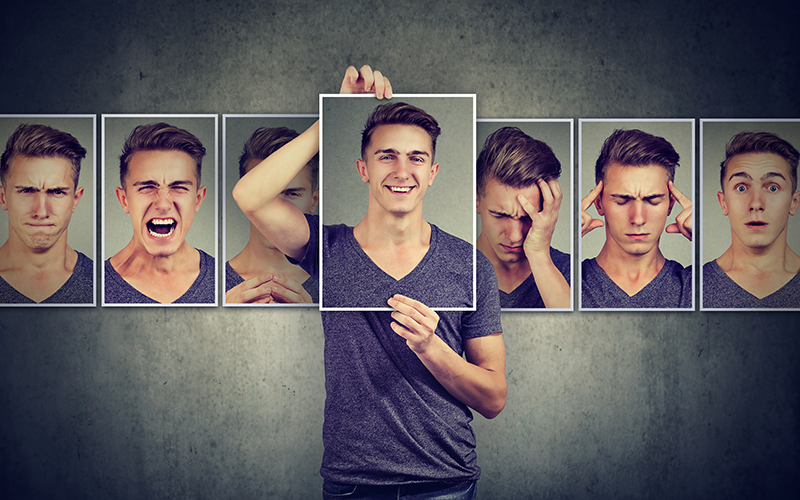Bipolar Disorders
Beyond Mood Swings: Understanding Bipolar Disorders
Bipolar disorders are not simply mood swings or occasional bouts of sadness and happiness. They are complex mental illnesses characterized by extreme shifts in mood, energy levels, and behavior. These shifts can be dramatic and disruptive, impacting every aspect of a person’s life.
A Rollercoaster of Emotions: Recognizing the Signs of Bipolar Disorders
While everyone experiences changes in mood and energy levels, bipolar disorders are distinguished by the intensity, duration, and impact of these shifts. Here’s what sets them apart:

- Extreme Mood Episodes: Bipolar disorders involve two distinct mood states: manic episodes (episodes of abnormally elevated mood or irritability) and depressive episodes (periods of intense sadness and hopelessness).
- Duration: Manic episodes typically last for at least seven days, while depressive episodes can persist for at least two weeks.
- Severity: Both manic and depressive episodes can be severe, significantly impacting a person’s ability to function at work, school, and in relationships.
A Spectrum of Bipolar Experiences: Different Types of Bipolar Disorders
There are different types of bipolar disorders, each with its own characteristics:
- Bipolar I Disorder: Defined by the presence of at least one manic episode, often accompanied by depressive episodes.
- Bipolar II Disorder: Characterized by a pattern of hypomanic episodes (milder version of mania) and depressive episodes.
- Cyclothymic Disorder: Involves numerous hypomanic and depressive episodes, but not meeting the full criteria for bipolar I or II.
A Tangled Web of Causes: What Triggers Bipolar Episodes?
The exact cause of bipolar disorder remains unknown. However, it’s likely a combination of factors:
- Genetics: Having a family history of bipolar disorder significantly increases the risk.
- Brain Chemistry: Imbalances in brain chemicals like serotonin and norepinephrine may play a role in mood regulation.
- Environmental Factors: Stressful life events, sleep disturbances, or substance abuse can trigger episodes in some individuals.
Living on the Edge: The Impact of Bipolar Disorders
Bipolar disorders can have a devastating impact on a person’s life. Manic episodes can lead to impulsive decisions, reckless behavior, and financial problems. Depressive episodes can cause social isolation, relationship problems, and suicidal thoughts.
Finding Balance: Treatment Options for Bipolar Disorders
The good news is that bipolar disorders are treatable with the right approach. Here are some common treatment methods:
- Mood Stabilizers: These medications are the cornerstone of treatment, helping to regulate mood swings and prevent future episodes.
- Antidepressants: These may be used to treat depressive episodes or in combination with mood stabilizers.
- Psychotherapy: Therapy can help individuals understand their condition, develop coping mechanisms, and learn to manage their moods.
- Lifestyle Changes: Maintaining a regular sleep schedule, exercising regularly, and avoiding alcohol and drugs are crucial for managing bipolar disorder.

Beyond Mood Swings: Understanding Bipolar Disorders
Bipolar disorders are not simply mood swings or occasional bouts of sadness and happiness. They are complex mental illnesses characterized by extreme shifts in mood, energy levels, and behavior. These shifts can be dramatic and disruptive, impacting every aspect of a person’s life.
A Rollercoaster of Emotions: Recognizing the Signs of Bipolar Disorders
While everyone experiences changes in mood and energy levels, bipolar disorders are distinguished by the intensity, duration, and impact of these shifts. Here’s what sets them apart:
- Extreme Mood Episodes: Bipolar disorders involve two distinct mood states: manic episodes (episodes of abnormally elevated mood or irritability) and depressive episodes (periods of intense sadness and hopelessness).
- Duration: Manic episodes typically last for at least seven days, while depressive episodes can persist for at least two weeks.
- Severity: Both manic and depressive episodes can be severe, significantly impacting a person’s ability to function at work, school, and in relationships.
A Spectrum of Bipolar Experiences: Different Types of Bipolar Disorders
There are different types of bipolar disorders, each with its own characteristics:
- Bipolar I Disorder: Defined by the presence of at least one manic episode, often accompanied by depressive episodes.
- Bipolar II Disorder: Characterized by a pattern of hypomanic episodes (milder version of mania) and depressive episodes.
- Cyclothymic Disorder: Involves numerous hypomanic and depressive episodes, but not meeting the full criteria for bipolar I or II.
A Tangled Web of Causes: What Triggers Bipolar Episodes?
The exact cause of bipolar disorder remains unknown. However, it’s likely a combination of factors:
- Genetics: Having a family history of bipolar disorder significantly increases the risk.
- Brain Chemistry: Imbalances in brain chemicals like serotonin and norepinephrine may play a role in mood regulation.
- Environmental Factors: Stressful life events, sleep disturbances, or substance abuse can trigger episodes in some individuals.
Living on the Edge: The Impact of Bipolar Disorders
Bipolar disorders can have a devastating impact on a person’s life. Manic episodes can lead to impulsive decisions, reckless behavior, and financial problems. Depressive episodes can cause social isolation, relationship problems, and suicidal thoughts.
Finding Balance: Treatment Options for Bipolar Disorders
The good news is that bipolar disorders are treatable with the right approach. Here are some common treatment methods:
- Mood Stabilizers: These medications are the cornerstone of treatment, helping to regulate mood swings and prevent future episodes.
- Antidepressants: These may be used to treat depressive episodes or in combination with mood stabilizers.
- Psychotherapy: Therapy can help individuals understand their condition, develop coping mechanisms, and learn to manage their moods.
- Lifestyle Changes: Maintaining a regular sleep schedule, exercising regularly, and avoiding alcohol and drugs are crucial for managing bipolar disorder.
